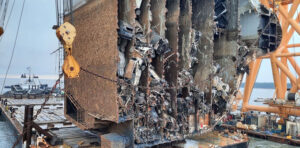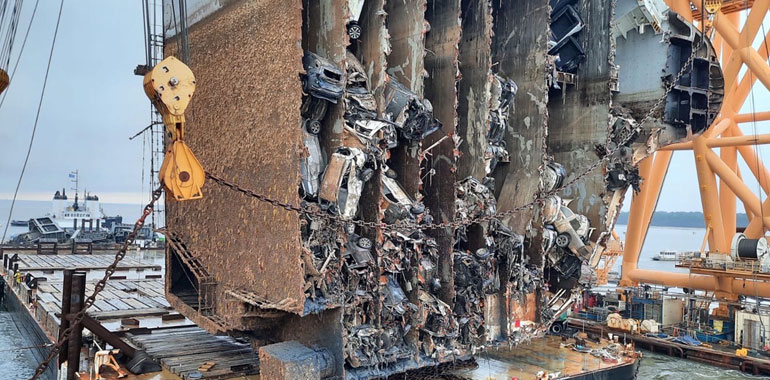
One of the most challenging salvage operations in U.S. maritime history is making headway, piece by piece, a year and a half after the vehicle carrier Golden Ray capsized and caught fire in Georgia’s St. Simons Sound.
The 656-foot ship, weighing in at 71,178 gross tons, is resting on its starboard side about a half-mile from St. Simons Island. As many as 400 people and 50 vessels — including construction barges, tugboats and environmental response boats — have been working on Golden Ray’s salvage, according to St. Simons Sound Incident Response.
“I’ve been working on response for over 20 years, but not a salvage this complex, because there has never been a salvage that is this complex,” said incident commander Chris Graff of Gallagher Marine Systems of Moorestown, N.J., which is overseeing the project.
Golden Ray, carrying about 4,200 vehicles, was leaving the Port of Brunswick on Sept. 8, 2019 when the ship capsized. All 24 crew were rescued. A preliminary analysis by the U.S. Coast Guard determined the rollover likely was caused by a combination of vehicles placed too high on the ship’s decks and not enough ballast water aboard given the placement of the cargo.
Salvage crews have faced many ensuing obstacles, including working amid the COVID-19 pandemic, hurricanes, the need for extensive pollution containment, and a 5-knot current in St. Simons Sound.
“The hurricane season for 2020 was one of the biggest seasons we’ve experienced, so that has complicated the response, and we’ve had some no-name weather conditions” that caused additional delays, said Coast Guard Cmdr. Efren Lopez, the federal on-scene coordinator.
In June, 10 responders tested positive for COVID-19. As a result, salvage leaders implemented a stronger safety policy, according to Lopez. This included separating various personnel into self-contained groups.
“We keep all of the teams in their own separate bubbles,” Graff said. Since then, “we’ve probably had an excess of 1,000 people coming and going, and we’ve only had a handful of people who have tested positive for COVID.”
In late July, coordinators paused salvage operations for two months due to the coronavirus outbreak and the possible impact of storms during the hurricane season.
As of Jan. 7, T&T Salvage of Galveston, Texas had cut and removed two sections of the ship. Salvors decided that Golden Ray would be cut into eight sections, each weighing between 2,700 and 4,100 tons, with the pieces transported one at a time by barge to Modern American Recycling Services in Gibson, La.
The cutting and lifting of the sections is being done by Versabar’s VB-10,000, the largest heavy-lift vessel ever built in the United States. The twin-barge catamaran has two 240-foot-tall gantries, four main hoist blocks and a lift capacity of 7,500 tons.
From April through June, T&T Salvage attached 16 lifting lugs to the hull, pieces of metal weighing between 35 and 85 tons that are the connecting points between the rigging of VB-10,000 and each section of the wreck, according to Coast Guard Petty Officer 2nd Class Michael Himes, spokesman for St. Simons Sound Incident Response. Two lifting lugs are attached to each section.
The cutting is done with a 400-foot chain that moves at about 7 feet per minute, slowly weakening the steel along the groove, according to Himes. The chain is made of 3-inch-diameter steel links 18 inches long that weigh about 80 pounds. Before each cut, holes are drilled in the hull to keep the chain in line.
“(The chain) uses a combination of friction and the weight of the wreck to do these cuts,” Graff said.
Cutting the bow (section 1) from the ship started on Nov. 6 and finished on Nov. 28. The section was loaded onto the 400-foot Crowley barge Julie B., which was transported to Modern American Recycling in December. It was the first time VB-10,000 had been used to divide a ship.
“We took lessons (from) the first cut and we made modifications for the second cut,” Lopez said.
After the first cut took 21 days, the second cut — removing the stern (section 8) — took only eight and a half days. The second cut included changes in the cutting angle, modifications to the blocks and pulleys to increase the durability of the chain, and replacing some of the links with a higher grade of steel, according to Himes.
On Jan. 5, section 8 was transported to a local facility aboard Crowley Barge 455-8 for sea fastening and ballasting before making the trip to Louisiana.
In the fall of 2019 and winter of 2020, about 327,000 gallons of an oil and water mixture were removed from the wreck. In December 2019, salvors removed the rudder and propeller, which together weighed 130 tons.
Starting in February 2020, an environmental protection barrier was built around the wreck. After Weeks Marine installed 80 pilings, netting made of high-tensile polyester was put in place between the pilings from the seabed to above the surface of the sound.
There is no official estimate for a completion date for the salvage. “Each section is different and the plan (will change) when we get to the middle sections,” Himes said.

